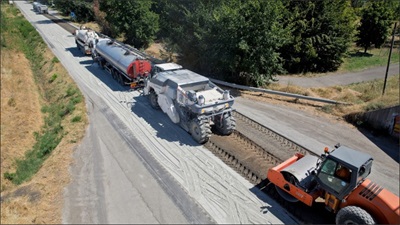Full Depth Recycling - Cement (FDR-C)
Technologies such as FDR-C can help Caltrans achieve both environmental and economic goals. By limiting landfill material, reducing truck trips and saving taxpayer dollars, consideration should be given to in-place recycling strategies when conditions are appropriate.
Full Depth Recycling (FDR-C) is a pavement rehabilitation technique in which the full thickness of the asphalt pavement and a portion of the underlying layers, along with a small percentage of added cement, are pulverized to provide a homogeneous pavement material. The stabilized material is then compacted in-place with rollers, resulting in a stiff, stabilized base course ready for a new surface course. An FDR-C layer generally consists of the following components:
- Recycled asphalt pavement (RAP)
- Cement stabilizer
- Supplemental aggregates, if required
- Asphalt emulsion as the curing compound
- Tack coat
FDR-C addresses cracking and rutting issues, subgrade instability, ride quality, raveling, potholes, bleeding, and decreased structural capacity of the pavement. As with conventional HMA, a proper site investigation is required to ensure good structural and mix design.

Figure 1. Full Depth Recycling Train
Mix Design
The general procedure for FDR mix design is as follows:
- Samples should include the subgrade in addition to underlying layers of pavement
- Process old HMA to obtain RAP
- Combine materials and determining gradation, Atterberg Limits (optional), Soil Classifications, and optimum moisture contents, sulfates, and chlorides.
- Determine maximum dry density and optimum moisture content of combined material
- If stabilizing agent is required, test stabilizing agent properties and material compatibility
- Mix and compact materials at different percentages of the stabilizing agent
- Cure specimens
- Test trial specimens for strength to determine optimum stabilization percentage
- Establish mix design formula
- Construct FDR pavement and adjust if necessary
Unconfined Compressive Strength Test
For FDR-C, specimens should be tested for unconfined compressive strength. The mix design must include 7-day unconfined compressive strength tests on specimens with 3 cement contents using the proposed cement and optimum moisture content, selected by the designer. Note: Stronger does not always equal better. The tests should meet the specified design strength, but the strengths should not deviate significantly. If UCS test results are too low, then the FDR-C layer may not be able to fully support the expected traffic. If the strengths are too high, this may result in reflective cracking in the surface layer due to drying shrinkage cracking of the FDR-C layer.
Micro-cracking
The FDR-C surface is typically microcracked 46 to 56 hours after compaction to mitigate drying shrinkage.

Figure 2. Microcracking
Quality Control
Variability in the HMA along the length of the roadway is inevitable, ranging from patches to change in design or thickness from previous projects or contracts. A good Quality Control plan should be able to accommodate the following variables encountered in recycling techniques:
- Gradation of aggregate, binder content, and moisture content of RAP
- Amount of recycling agent to be added
- Extent of patching and other anomalies in the roadway
- Nature and amount of distress such as cracking or other deterioration
- Final compacted density of recycled layer
Special Considerations
FDR-C should not be performed when the pavement is frozen or freezing temperatures are anticipated within 7 days of the end of FDR-C placement. Do not start FDR-C activities if the ambient air temperature is below 40 degrees F or the road surface is below 40 degrees F. If the ambient air temperature falls below 40 degrees F during the FDR-C activities, the contractor may only compact and finish FDR-C.
FDR-C will not solve subgrade drainage issues. The aged pavement may be recycled and stockpiled so that the underlying issues may be addressed prior to grading and compacting recycled material.
If the existing pavement contains geotextiles, they may remain in the recycled layer if it can be pulverized and does not affect the performance of the pavement.
Implementation
Specifications for FDR-C may be found in the 2018 Standard Specifications Section 30-4 Full Depth Reclamation-Cement. Refer to the Highway Design Manual for structural design guidance of FDR-C. RSS-30-4 and SSP-30-4 are available for use.
Please forward any questions/comments/suggestions to fdr@dot.ca.gov.
Resources
- Highway Design Manual: Chapter 630 Flexible Pavement
- Caltrans In-Place Recycling Manual
- DES Website
- Office of Asphalt Pavement
- Wirtgen Cold Recycling Technology Manual (external link)
- Road Resource Website (external link)
- Portland Cement Association Manual (upon request)

